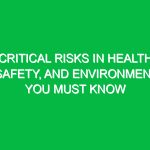Introduction
Personal Protective Equipment (PPE) is a critical component of workplace safety, especially within the Health, Safety, and Environment (HSE) domain. But what is PPE equipment, really? It encompasses a variety of protective gear designed to shield individuals from workplace hazards that could result in injuries or illnesses. The significance of PPE cannot be overstated; it acts as a last line of defense against potential dangers, making it essential for industries ranging from construction and manufacturing to healthcare and laboratories.
As workplaces evolve and new hazards emerge, understanding what PPE equipment entails becomes increasingly vital. This article delves deep into the various types of PPE, their importance in ensuring health and safety, the regulations governing their use, and the best practices for selecting and utilizing them effectively.
Understanding PPE Equipment in the HSE Context
PPE includes a wide range of equipment designed to protect workers from specific hazards. Understanding what is PPE equipment involves recognizing its various categories, which include:
- Head Protection: Helmets and hard hats designed to protect against falling objects and head injuries.
- Eye and Face Protection: Safety goggles, face shields, and safety glasses that shield the eyes and face from chemical splashes, flying debris, and intense light.
- Hearing Protection: Earplugs and earmuffs designed to protect against noise-induced hearing loss in loud environments.
- Respiratory Protection: Masks and respirators that filter out harmful airborne particles, gases, and vapors.
- Hand Protection: Gloves made from various materials to protect against cuts, chemicals, and abrasions.
- Foot Protection: Safety boots and shoes that provide support and protection from heavy objects and slippery surfaces.
- Body Protection: Coveralls, vests, and aprons that protect against hazardous materials and environmental conditions.
Each type of PPE is designed with specific functions in mind, and proper selection is crucial to ensure maximum protection.
The Importance of PPE in Workplace Safety
In the context of HSE, PPE serves several crucial roles:
1. **Hazard Mitigation:** PPE reduces the risk of injury or illness, thus promoting a safer work environment. For example, during construction projects, wearing hard hats can significantly decrease the likelihood of head injuries from falling debris.
2. **Regulatory Compliance:** Many industries are governed by health and safety regulations that require PPE use. Compliance not only protects employees but also shields employers from legal repercussions and fines.
3. **Employee Morale:** Providing proper PPE demonstrates an employer’s commitment to employee safety. This can enhance morale, job satisfaction, and productivity.
4. **Workplace Culture:** A culture that prioritizes safety encourages employees to take personal responsibility for their well-being and the well-being of their colleagues.
Identifying Hazards and Risks
Understanding what is PPE equipment also involves recognizing the hazards that necessitate its use. Common workplace hazards include:
– **Physical Hazards:** These include falling objects, moving machinery, and uneven surfaces that can lead to slips, trips, and falls.
– **Chemical Hazards:** Exposure to harmful chemicals can occur in various industries, necessitating the use of gloves, goggles, or respirators.
– **Biological Hazards:** In healthcare settings, PPE such as gowns, masks, and face shields protect against exposure to infectious agents.
– **Ergonomic Hazards:** Improper lifting techniques can lead to musculoskeletal injuries, highlighting the need for proper training and protective gear.
Real-life examples abound. In a manufacturing plant, one employee suffered a severe hand injury due to a lack of proper gloves while handling sharp materials. This incident not only led to personal suffering but also costly downtime and injury claims for the company. Such scenarios underline the importance of identifying risks and equipping workers with the necessary PPE.
Best Practices for Selecting and Using PPE
Choosing the right PPE involves several steps that ensure effectiveness:
1. **Hazard Assessment:** Identify specific workplace hazards. Conduct a thorough assessment to understand the risks involved in each job function.
2. **PPE Selection:** Based on the hazard assessment, select appropriate PPE that meets the required safety standards. For instance, when working with chemicals, ensure that gloves are resistant to the specific substances employees may encounter.
3. **Training:** Provide comprehensive training on the proper use, maintenance, and limitations of PPE. Employees should know how to wear and adjust their protective gear correctly.
4. **Regular Inspections:** Conduct regular checks of PPE to ensure they are in good condition. Worn-out or damaged equipment should be replaced immediately.
5. **Feedback Mechanism:** Encourage employees to provide feedback on PPE effectiveness. Their insights can lead to improvements in safety practices and equipment selection.
Regulations and Standards Governing PPE
In many countries, regulations dictate the use of PPE to safeguard workers. In the United States, the Occupational Safety and Health Administration (OSHA) sets forth standards that employers must comply with regarding PPE in the workplace. These regulations mandate that employers provide appropriate PPE at no cost to employees and ensure that it is used correctly.
In Europe, similar regulations exist under the Personal Protective Equipment Regulation (EU) 2016/425, which governs the design, manufacture, and marketing of PPE. Understanding these regulations is vital for organizations to ensure compliance and promote a safe working environment.
Case Studies Highlighting the Importance of PPE
Several case studies illustrate the critical role that PPE plays in workplace safety:
– **Construction Site Incident:** A construction worker fell from scaffolding while not wearing a harness. This incident led to severe injuries and a lengthy recovery process. Following this event, the site management instituted a strict PPE policy that included mandatory harness use for all employees working at heights. After implementing these changes, the site reported zero falls over the next year.
– **Chemical Exposure in Laboratories:** In a university laboratory, a research assistant accidentally spilled a hazardous chemical. Fortunately, the assistant was wearing a lab coat, gloves, and goggles. Although the spill was significant, the PPE prevented any injuries. This incident reinforced the importance of wearing appropriate protective gear in laboratory settings.
These case studies underscore the need for consistent PPE use and adherence to safety protocols.
Conclusion
In conclusion, understanding what is PPE equipment and its significance in the HSE context is imperative for creating a safe work environment. The appropriate use of PPE not only mitigates risks but also fosters a culture of safety and compliance within organizations.
From head protection to foot safety, each aspect of PPE serves a vital purpose in safeguarding employees from workplace hazards. By conducting thorough hazard assessments, selecting the right equipment, providing proper training, and adhering to regulations, organizations can significantly reduce the likelihood of injuries and illnesses.
As workplaces continue to evolve and new hazards emerge, the importance of PPE in promoting health, safety, and environmental sustainability cannot be overstated. Organizations must remain vigilant, proactive, and committed to protecting their most valuable asset—their employees.


